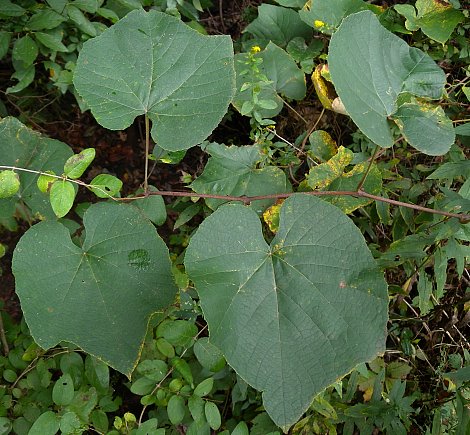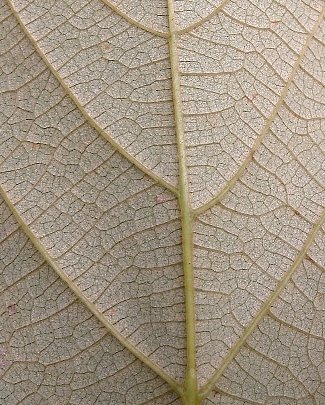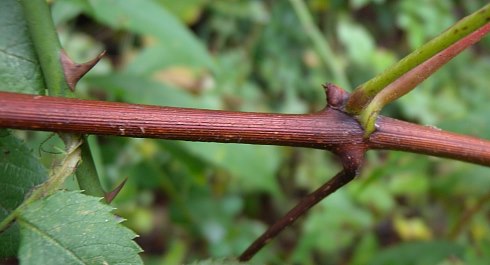
Sometimes panicles of flowers about 3-6" long develop along the stems of a vine. These panicles are often wider toward their bases than at their tips. Individual flowers are about 1/8" (3 mm.) across and greenish yellow in appearance. These flowers can be unisexual (male or female) or perfect. Each flower has 5 deciduous petals, an insignificant calyx that has been reduced to a flat disk, and the reproductive organs. Each male or perfect flower has 5 prominent stamens, while each female or perfect flower has a superior ovary with a short style. The blooming period occurs during late spring or early summer and lasts about 1 week. The flowers have a sweet musty fragrance. Fertile female flowers are replaced by berries that are arranged in drooping panicles about 3-8" long. After they mature during the late summer or the fall, these berries are ½-¾" across and globoid to globoid-ovoid in shape. They are bluish black (rarely amber) and either with or without bloom on the outside, while on the inside they have juicy flesh and 2-6 seeds. The flavor of ripe berries varies from sweet-tart to sweet with musky overtones. This woody vine spreads by reseeding itself.
Cultivation: The preference is full or partial sun, wet to mesic conditions, and soil that is sandy or rocky, although other soil types are tolerated. Flooded conditions are tolerated if they are temporary.

Range & Habitat: Fox Grape is native to eastern North America, but it has not been collected in Illinois (see Distribution Map). However, the wild form of Fox Grape is quite common across the border in Indiana along Lake Michigan, therefore it is possible that this vine occurred in Illinois at one time as a native species. In our area, habitats consist of wet to mesic sandy thickets, borders of sandy woodlands, riverbanks, areas along roadsides and railroads, and wet to moist sand prairies. Occasional wildfires and other disturbances are beneficial if this reduces competition from canopy trees.
Faunal Associations: Fox Grape and other wild grape vines (Vitis spp.) are highly beneficial to wildlife. The flowers are cross-pollinated by bumblebees, honeybees, and long-horned bees (Eucera spp.). These insects usually collect pollen from the flowers (Robertson, 1929). A wide variety of other insects feed on the foliage, suck plant juices, bore through the woody branches, and eat other parts of these woody vines. These species include larvae of long-horned beetles, leaf beetles, weevils, scarab beetles (including the Japanese Beetle), aphids, spittlebugs, leafhoppers, treehoppers, armored scales, Grape Phylloxera (Daktulasphaira vitifoliae), mealybugs, thrips, Giant Walkingstick (Megaphasma denticrus), and larvae of such moths as Geometer moths, leaf blotch miner moths (Gracillariidae), shield-bearer moths (Heliozelidae), owlet moths (Noctuidae), Sphinx moths, and window-winged moths (Thyrididae). The Insect Table provides more information about these insect feeders. Many birds feed on the ripened fruit of Fox Grape and other wild grapes, including tanagers, crows, blackbirds, orioles, woodpeckers, thrushes, vireos, upland gamebirds, some sparrows, and some warblers (see Bird Table). Many birds also like to feed on the insects that are attracted to these woody vines, and birds seek protective cover and construct nests in them. Mammals also use Fox Grape and other wild grapes as a source of food. White-tailed Deer and Domestic Goats feed on the foliage and small branches, while the American Black Bear, Gray Fox, American Red Fox, Virginia Opossum, Raccoon, Striped Skunk, Spotted Prairie Skunk, and Fox Squirrel eat the ripened fruits (Sokala & Kirkpatrick, 1973; Blackmore, 1998; Martin et al., 1951/1961; Beeman & Pelton, 1980). The fruit of sprawling wild grape vines are sometimes eaten by the Eastern Box Turtle (Ernst et al., 1994). These vines also provide protective cover for these mammals.

Photographic Location: Edge of a sandy woodland at the Indiana Dunes National Lakeshore in NW Indiana.
Comments: Among wild grapes (Vitis spp.) in Illinois, Fox Grape usually has better-tasting berries than most. Fox Grape is a parent of such grape cultivars as Catawba, Concord, Delaware, Niagara, and others. Many cultivated grapes are actually hybrids of Vitis labrusca (Fox Grape) and the European Vitis vinifera (Wine Grape). Such hybrids are collectively referred to as Vitis × labruscana (Labruscan Grape) and they may differ from the wild Fox Grape in a number of characteristics. Fox Grape is readily distinguished from other wild grapes in Illinois by its production of either tendrils or flowers/fruit across from each and every leaf. Other wild grapes have tendrils and flowers/fruits missing from every third leaf. Fox Grape also has larger fruits (½" or more) and larger seeds than other wild grapes. Its leaves resemble those of Vitis aestivalis (Summer Grape) in that their undersides are covered with woolly hairs, but the leaves of Fox Grape rarely have deep narrow lobes and their margins have smaller teeth. The common name of Vitis labrusca is potentially confusing as it sometimes refers to Vitis vulpina (Frost Grape), where 'vulpina' refers to the Latin word for 'fox.'